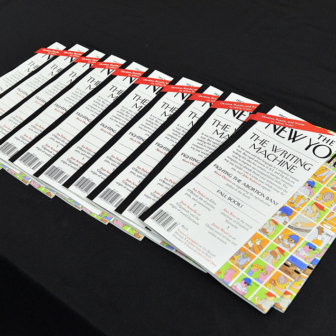Wednesday’s announcement that the regional television network WIN will stop producing five local news bulletins and close newsrooms across New South Wales and Queensland is the latest blow to local news across Australia.
Newsrooms are slated to close in Orange, Wagga Wagga, Albury and Hervey Bay. More journalists’ jobs will be lost.
The crisis in the media’s business models is being felt most acutely in local news. For many Australians it is now easier to find out what Donald Trump had for dinner last night than what’s happening at your local school, what the story was behind that column of smoke on the horizon yesterday or why the potholes in the road haven’t been fixed.
In our recent study of local journalism, a third of local governments responding to our survey reported that no journalists attended their council meetings. Evidence suggests a decline in local news in 68 per cent of suburbs and 45 per cent of rural and regional areas over the past five years.
The old cliché, information is power, holds true. Without local news, local institutions are less accountable, citizens are disempowered and power transfers to those with the ability and motivation to manipulate public opinion.
This is the backdrop to WIN’s announcement. But the broadcaster’s decision also raises questions about the effectiveness of regulations designed to ensure that an important public asset — the broadcasting spectrum — is used to benefit local communities.
Starting in the 1980s, regional television in the eastern states was restructured into five huge “aggregated” licence areas — Southern New South Wales, Northern New South Wales, Regional Victoria, Regional Queensland and Tasmania — for the purposes of regulation. The idea was that at least three commercial services would be available in each of them. Each licence area was also divided into local divisions, reflecting communities and markets.
Part of the deal under which local networks were allowed to move into more markets was that they would broadcast a minimum amount of “content of local significance” in each of the local areas their broadcasts cover. Under a points system, broadcasters receive the most points for local news bulletins “depicting people, places or things in the local area.” To earn the highest points, the news needs to include moving images, and simply using file footage isn’t sufficient.
But broadcasters can also earn up to half their points for content that is of relevance not to the local area but only to the much larger licence area. In theory, WIN can earn up to half its points in Dubbo by broadcasting news about Wollongong. It can also get 10 per cent of its points for community service announcements.
Despite these potential shortcomings, the content obligations have worked reasonably well, according to the Australian Communications and Media Authority’s 2017 report on local content. People living in the local obligation areas were significantly more likely to be satisfied with the overall amount of local news on television, the regulator found.
So what impact will the latest closures have on WIN’s licence obligations? WIN was less than helpful when we approached it yesterday, responding to a list of questions with a single sentence: “WIN continues to meet its licence obligations.” Requests for more information about how this was to be done have still not been answered.
Meanwhile, ACMA only became aware of WIN’s plans through media reports. “We are looking at whether the closures raise any issues,” said a representative.
So, do they raise issues?
In regional Queensland, WIN’s decision to close its Hervey Bay newsroom doesn’t seem to breach the regulations. WIN was allowed to choose five out of the licence area’s seven local areas to fulfil local content obligations. WIN chose Far North Queensland, North Queensland, Capricornia, the Sunshine Coast and Darling Downs, all likely to be more commercially viable areas than Wide Bay. That suggests the closure at Hervey Bay has no implications for WIN’s licence.
The picture is much more complicated in New South Wales. There, WIN has content obligations in all local areas — but there is no requirement about where the obligations are met, as in where news is produced, just that the material directly relates to the local area.
Dubbo and Orange both sit within the same Central Tablelands local area, along with the surviving WIN newsroom in Bathurst, two weary hours’ drive from Dubbo. And pity Wagga Wagga, alone in the South Western Slopes and now to be closed. WIN has no other newsrooms nearby — other than in Canberra, nearly three hours’ drive away.
Orange and Wagga are within the Southern New South Wales licence area, along with WIN’s headquarters, in Wollongong. We can expect news coverage to be increasingly coordinated from there. As for Albury, which is in the Regional Victoria licence area, the nearest remaining newsroom, and the only remaining one in the local area, is in Shepparton.
So how will WIN continue to satisfy its obligations, particularly given that it still needs to provide “moving images” of local people, places and things for at least some of its required points?
Earlier closures in Tasmania give us some of the picture. Last August WIN announced it would close its news bulletin in that state. Nine jobs were lost, but a skeleton staff of camera operators was left on the ground to provide content for a bulletin produced in Wollongong.
As ACMA observed in its local news report, the profitability of regional broadcasting is declining under the same pressures that are affecting media across the Western world — fragmenting audiences and the disappearance of advertising revenue to social media platforms.
Nor can we expect things to get better. All the reports from industry observers predict it will get worse unless there is government intervention. That’s part of what the Australian Competition and Consumer Commission’s Digital Platforms Inquiry is looking at for a report due at the end of this month.
While WIN’s statement this week said that no cuts are planned in any other areas, it is easy to see that the long-term plan might well be to have just one newsroom in each local area they cover.
Meanwhile, WIN has begun to fill airtime by broadcasting content from the twenty-four-hour news channel Sky News across all its markets nationwide. Sky News is a solid national news service during daylight hours, but Sky After Dark is a very different beast, populated nearly exclusively by hard-right commentators.
At the same time as local news in the regions declines, right-wing commentary not watched by most urban Australians is becoming freely available to rural viewers.
The long-term effect of declining local news will be more fractured communities and less national consensus. Increasingly, we can expect to be taken by surprise by the views of our fellow Australians. We should all be concerned.
All news is local. The affairs of the suburbs and regions, aggregated, make up the affairs of the nation. Without local news, we are all the poorer.
We should hope that the new communications minister, Paul Fletcher, is thinking about these issues. •




